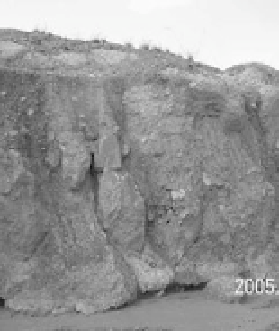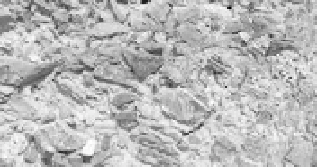Environmental Engineering Reference
In-Depth Information
Characteristics of the grain size distribution are, of course, closely related to the supply conditions of
sediment in the watershed. On the other hand, the grain size distribution is also affected by the selectivity
of the movement pattern to solid grains, Figure 4.51(b) shows the grain size distributions in a debris flow
development process from torrential flood low-viscous debris flow, viscous debris flow that occurred in
the Jiangjia Ravine (Kang, 1985b). Suspended load dominates in the torrential flood and the size distribution
had only one peak of frequency density. In sub-viscous and viscous debris flows, however, neutrally buoyant
load dominates, adding one peak of much coarser grain size to the lower peak of finer particles.
4.3.3.7
Sorting of Debris Flow Deposits
Generally speaking, deposits from pseudo-one-phase debris flows consisting of clay, sand, and gravel, are a
well mixed mixture of various particles. In the Bailong River, the thickness of debris flow deposits is as
much as 30-50 m. The profile of the deposit shows huge stones and gravels mixed together with sand and
clay (Li and Deng, 1985). But two-phase debris flows occasionally bring about inverse grading of the
deposit (upward coarsening deposit), which is quite different from sedimentation in rivers. Such a unique
sorting is a characteristic of deposits of two-phase debris flows, in which there is little clay and silt.
(a) (b)
Fig. 4.52
(a) Viscous debris flow deposits in the Dabaini Ravine in the Xiaojiang watershed; (b) Viscous debris flow
deposits in a debris flow gully in the Bailong River basin in Gansu Province (See color figure at the end of this topic)
Deposits from low-viscous debris flows usually are positive graded (upward fining), and deposits from
viscous and subviscous debris flows are well mixed. In general, deposits from debris flows usually are
well mixed, but sometimes may be inverse graded, or positive graded. Figure 4.52 shows the viscous
debris flow deposit in the Dabaini Gully in the Xiaojiang watershed on the Yunnan-Guizhou Plateau (a);
and viscous debris flow deposit in a debris flow gully in the Bailong River basin in Gansu Province (b).
Large stones and fine materials are well mixed, which implies that solid material with different sizes
moved together during viscous debris flows.
4.3.3.8
Serious Degradation and Aggradation
Debris flow often results in great degradation in the upstream and serious aggradation at the mouth of the
gully. For instance, in the upstream of the Bomi-Guxiang Gully in Tibet, the gully bed was cut down
140-180 m in the period 1954-1963, or 16 m annually (Deng, 1985). It was observed that degradation of
the debris flow gully resulted mainly from retrogressive erosion as debris flow occurred. In a debris flow
in the Guxiang Gully in 1964, a 1-m-bed drop moved upstream at a speed of 1 m/min. Sometimes debris
flow brings about another type of erosion wherein large stones in the surge head dig a ditch into the bed




Search WWH ::

Custom Search